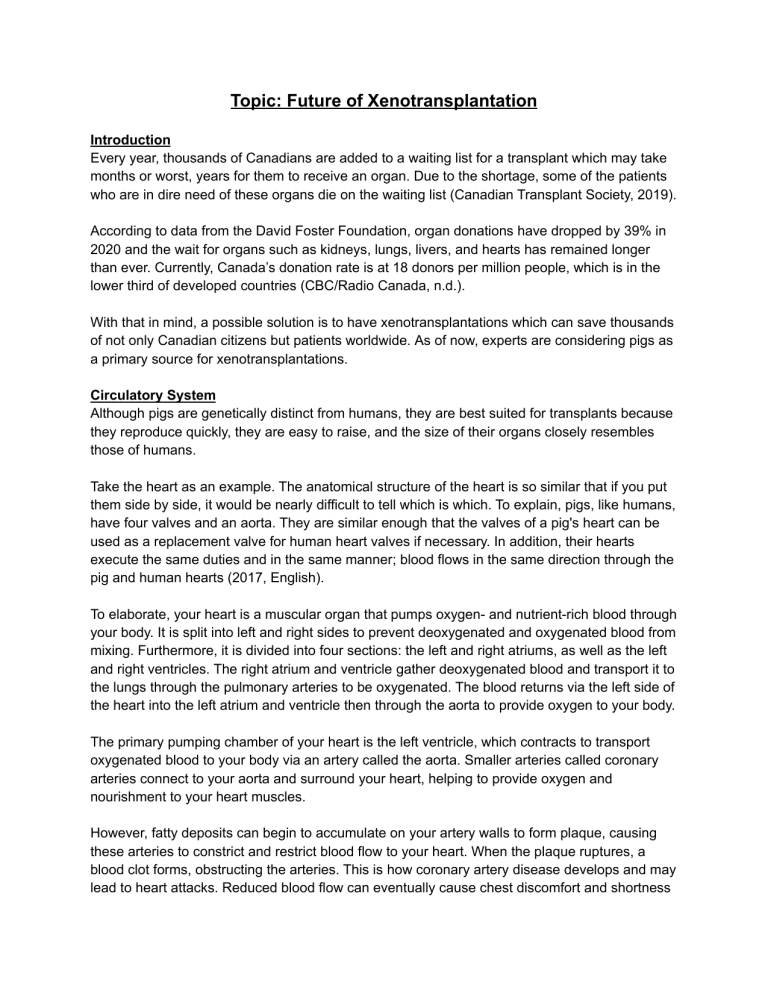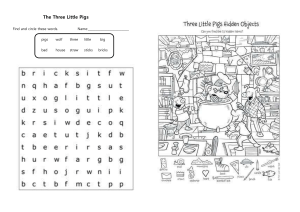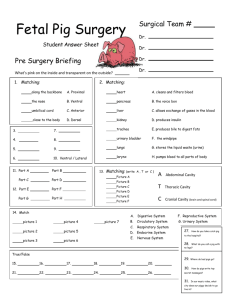
Topic: Future of Xenotransplantation Introduction Every year, thousands of Canadians are added to a waiting list for a transplant which may take months or worst, years for them to receive an organ. Due to the shortage, some of the patients who are in dire need of these organs die on the waiting list (Canadian Transplant Society, 2019). According to data from the David Foster Foundation, organ donations have dropped by 39% in 2020 and the wait for organs such as kidneys, lungs, livers, and hearts has remained longer than ever. Currently, Canada’s donation rate is at 18 donors per million people, which is in the lower third of developed countries (CBC/Radio Canada, n.d.). With that in mind, a possible solution is to have xenotransplantations which can save thousands of not only Canadian citizens but patients worldwide. As of now, experts are considering pigs as a primary source for xenotransplantations. Circulatory System Although pigs are genetically distinct from humans, they are best suited for transplants because they reproduce quickly, they are easy to raise, and the size of their organs closely resembles those of humans. Take the heart as an example. The anatomical structure of the heart is so similar that if you put them side by side, it would be nearly difficult to tell which is which. To explain, pigs, like humans, have four valves and an aorta. They are similar enough that the valves of a pig's heart can be used as a replacement valve for human heart valves if necessary. In addition, their hearts execute the same duties and in the same manner; blood flows in the same direction through the pig and human hearts (2017, English). To elaborate, your heart is a muscular organ that pumps oxygen- and nutrient-rich blood through your body. It is split into left and right sides to prevent deoxygenated and oxygenated blood from mixing. Furthermore, it is divided into four sections: the left and right atriums, as well as the left and right ventricles. The right atrium and ventricle gather deoxygenated blood and transport it to the lungs through the pulmonary arteries to be oxygenated. The blood returns via the left side of the heart into the left atrium and ventricle then through the aorta to provide oxygen to your body. The primary pumping chamber of your heart is the left ventricle, which contracts to transport oxygenated blood to your body via an artery called the aorta. Smaller arteries called coronary arteries connect to your aorta and surround your heart, helping to provide oxygen and nourishment to your heart muscles. However, fatty deposits can begin to accumulate on your artery walls to form plaque, causing these arteries to constrict and restrict blood flow to your heart. When the plaque ruptures, a blood clot forms, obstructing the arteries. This is how coronary artery disease develops and may lead to heart attacks. Reduced blood flow can eventually cause chest discomfort and shortness of breath since your body has to work harder and more frequently to pump more blood (Mayo Clinic, 2020). As of 2018, there have only been 189 heart transplants done in Canada (Canadian Institute for Health Information, 2019). This low figure is due not just to a low rate of organ donation, but also to the fact that heart transplants are more difficult to do. This is because of the precise measures required to transfer the heart from the donor to the recipient, as the heart can only live for 4-6 hours after being removed from the donor (Organ Donation FAQs, 2019). However, if pig heart transplants can be performed, the time and meticulous steps required to transport the heart to the recipient would be reduced. Digestive System One of the most common reasons for a liver transplant is the development of severe liver damage or liver disease, such as cirrhosis. Furthermore, cirrhosis is induced by excessive alcohol use, which shrinks the liver and decreases the production of bile, which is essential to the gallbladder to help break down fatty meals. To make matters worse, alcohol is the most used substance in Canada, with 78.2% of the general population (15+) regularly consuming alcohol (Canadian Centre on Substance Use and Addiction, 2019). When you drink alcohol, it reduces stomach acid production while simultaneously destroying your mucus lining, which is supposed to protect your stomach from acid and digestive enzymes that cause inflammation and sores. This limits the stomach's ability to kill bacteria that enter it, allowing potentially dangerous bacteria to enter the upper small intestine (Lapp, 2020). Only 20% of alcohol is absorbed through the stomach; the remainder is absorbed by the small intestine through the use of villi and microvilli, which subsequently travels into the body via the circulatory system (University of California, 2019). One alcoholic beverage takes your body around an hour to process because your liver can only handle so much alcohol at one time. This time duration grows with each drink meaning that the higher the alcohol concentration, the longer it takes to metabolize alcohol. Though, if a person consistently consumes too much alcohol, the body will start to replace the liver’s healthy tissue with scar tissue. As a result, this is how cirrhosis can develop and can increase your chances of getting liver cancer (Juergens, 2021). Using pig liver, on the other hand, can shorten the long wait for a liver. In pigs, there are a few differences in terms of placement, such as the human pancreas being adjacent to the stomach, whereas the pig pancreas is located underneath the stomach. An anatomical difference between a pig and a human digestive system is that a pig liver has five lobes, whereas a human liver has four lobes. However, this does not raise a red signal because it operates in the same manner as the human liver. Respiratory System Emphysema, a common type of chronic obstructive pulmonary disease (COPD), is one of the most recurrent causes for a lung transplant resulting from smoking, affecting around 10% of Canadians aged 35 and older. This condition causes inflammation and narrows the airway making the movement of oxygen through the lungs more difficult (Pietrangelo, 2021). When you inhale air, it passes through your trachea, which is lined with microscopic hairs called cilia, that move in a wavy motion to help filter and sweep dangerous chemicals out of your lungs. Smoke, on the other hand, kills cilia in your trachea due to its high temperature, causing it to swell and produce mucus (How Smoking Affects Your Lungs, 2018). Tar begins to collect in the bronchioles, blocking the cilia and creating mucus accumulation, causing the lungs to become black. Due to the buildup of tar and mucus, your airways narrow and create discomfort. Coughing is common among smokers in an attempt to clear away the sticky materials. As a result, there is less oxygen, which means cells have less energy to carry out the body's functions (Sudhir, 2018). After flowing through the trachea, bronchi, and bronchioles, the smoke will finally reach the alveoli, impairing their ability to exchange gas. Tar and carbon monoxide will occupy the air space in the alveoli, which is usually filled with air. Furthermore, carbon monoxide will reduce oxygen intake by competing with oxygen in hemoglobin, eliminating oxygen that would have been delivered to the rest of the body. This results in oxygen deprivation, which means that the lungs' air capacity is decreased (Sudhir, 2018). People with this disease frequently have longer wait times since their mortality risk is lower than that of other patients. As a result, these individuals move up and down the waiting list, making it more difficult for them to receive a lung transplant. However, people with heart problems may benefit from pig lung transplantation as they are simple to obtain and transplant. Though pig lungs are slightly different in structure, they serve the same function and process of receiving oxygen and expelling carbon dioxide. Pigs' lungs are flatter and contain more lobes than humans', with four on the right and three on the left. Despite having more lobes than humans, lung transplantation would be just as successful since they serve the same purpose and have the same structure. As a result, pigs are a viable choice for cardiac xenotransplantation. Dr. Chen’s View The advancement of xenotransplantation serves three advantages: supplementing human organs, possibly opening up new fields of study, and reducing the number of illegal organ donations. Xenotransplantation is currently not recognized as a medical practice and raises ethical concerns. However, with more clinical studies, investments, and demonstrated proof for the works, it could alleviate the wait for present and future transplant patients, perhaps saving many lives. Furthermore, these procedures have the potential to provide humanity with an infinite supply of cells, tissues, and organs. Whole hearts, lungs, livers, kidneys, and pancreas might be used as organ xenotransplants. Pigskin is an example of tissue transplants that could be utilized for skin grafts since it closely resembles human skin. Moreover, people suffering from diabetes, Alzheimer's, or Parkinson's disease may benefit from cellular xenotransplants. With xenotransplantation just getting started, we may be witnessing a new age in medicine for future generations. Bibliography Alcohol. Canadian Centre on Substance Use and Addiction. (2019). https://www.ccsa.ca/sites/default/files/2019-09/CCSA-Canadian-Drug-Summary-Alcohol2019-en.pdf. Annual Statistics on Organ Replacement in Canada: Dialysis, Transplantation and Donation, 2009 to 2018. Canadian Institute for Health Information. (2019). https://www.cihi.ca/sites/default/files/document/corr-snapshot-2019-en.pdf. The Burden of Chronic Disease in Ontario. Public Health Ontario. (2019, July). https://www.publichealthontario.ca/-/media/documents/c/2019/cdburden-report.pdf?la=en Canadian Transplant Society. (2019, April 26). https://www.cantransplant.ca/organ/. CBC/Radio Canada. (n.d.). Canadians are Dying Because Our Organ Donation Rate is Dismally Low. CBC news. https://www.cbc.ca/natureofthings/features/canadians-are-dying-because-our-organ-tran splant-rate-is-dismally-low. English, M. (2017, November 21). Why Are Pig Hearts Used to Study the Anatomy of the Human Heart? Education. https://education.seattlepi.com/pig-hearts-used-study-anatomy-human-heart-6155.html. How Smoking Affects Your Lungs. UPMC HealthBeat. (2018, August 29). https://share.upmc.com/2016/04/how-smoking-affects-lungs/. Juergens, J. (2021, March 25). Alcohol and the Liver - How Alcohol Damages the Liver. Addiction Center. https://www.addictioncenter.com/alcohol/liver/. Lapp, E. (2020, September 18). 7 Effects of Alcohol on Your Stomach & Digestive System. Raleigh House. https://www.theraleighhouse.com/addiction-blog/how-alcohol-affects-the-stomach. Liver Transplant. Johns Hopkins Medicine. (n.d.). https://www.hopkinsmedicine.org/health/treatment-tests-and-therapies/liver-transplant. Mayo Foundation for Medical Education and Research. (2020, June 5). Coronary artery disease. Mayo Clinic. https://www.mayoclinic.org/diseases-conditions/coronary-artery-disease/symptoms-caus es/syc-20350613. Nall, R. (2018, September 17). Alcoholic Liver Cirrhosis. Healthline. https://www.healthline.com/health/alcoholic-liver-cirrhosis. Organ Donation FAQs. BC Transplant. (2019). http://www.transplant.bc.ca/health-info/organ-donation/organ-donation-faqs. Pietrangelo, A. (2021, January 22). Everything You Need to Know About Chronic Obstructive Pulmonary Disease (COPD). Healthline. https://www.healthline.com/health/copd. Sudhir, K. (2018, September). How do cigarettes affect the body [Video]. TED Conferences. https://www.ted.com/talks/krishna_sudhir_how_do_cigarettes_affect_the_body?utm_ca mpaign=tedspread&utm_medium=referral&utm_source=tedcomshare Torres, F. (2017, October 11). When a doctor may recommend lung transplant to treat COPD, emphysema, or pulmonary fibrosis: Transplant: UT Southwestern Medical Center. Transplant | UT Southwestern Medical Center. https://utswmed.org/medblog/lung-transplant-copd-emphysema-pulmonary-fibrosis/. University of California. (2019). Alcohol and Your Body. https://shop.ucsc.edu/alcohol-other-drugs/alcohol/your-body.html. Virtual Fetal Pig Dissection. Whitman College. (n.d.). https://www.whitman.edu/academics/majors-and-minors/biology/virtual-pig/respiratory-sy stem. 1. Organ Donation FAQs (transplant.bc.ca) 2. Pros and Cons of Xenotransplantation - Vision Launch Media 3. Revised Fact Sheet on Xenotransplantation - Canada.ca 4. https://schoolworkhelper.net/fetal-pig-dissection-lab-answers/ 5. https://www.mayoclinic.org/tests-procedures/heart-valve-surgery/about/pac-20384901 6. https://www.ccsa.ca/sites/default/files/2019-09/CCSA-Canadian-Drug-Summary-Alcohol2019-en.pdf (has the 78% information) 7. https://www.whitman.edu/academics/majors-and-minors/biology/virtual-pig/digestive-syst em/the-head/rostral-oral-cavity 8. Organ Donation and Transplantation in Canada: Statistics, Trends and International Comparisons (parl.ca) 9. Annual Statistics on Organ Replacement in Canada: Dialysis, Transplantation and Donation, 2009 to 2018 (cihi.ca) (this has a graph of # of transplants in Canada) 10. Organ donations down, even as thousands of Canadians wait for transplants | CTV News Take, for example, the heart. The left and right atriums, as well as the left and right ventricles, are found in both humans and pigs. Pigs have four valves and an aorta, much like humans. The valves of a pig's heart are sufficiently close to those of human hearts that they may be utilised as a replacement valve if necessary. Consider the heart. The left and right atriums, as well as the left and right ventricles, are present in both humans and pigs. Pigs, like humans, have four valves and an aorta. The valves of a pig's heart are sufficiently identical that they may be utilised as replacement valves in human hearts if necessary. Furthermore, blood travels in the same direction through pig and human hearts. If they were placed side by side, it would be practically difficult to distinguish which is whose. Heartburn is frequently caused by excessive alcohol intake. It does this by relaxing the sphincter that is there to control the acidic contents of the stomach from passing into the esophagus. If this fluid makes it past the sphincter it can be highly irritating to the esophagus, and this is what causes heartburn.Alcohol Effects on the Digestive System - (alcoholrehab.com) *Ignore* (Digestive) Additionally, those with cirrhosis prevent the liver from producing bile therefore causing the gallbladder to develop gallstones because fat cannot be broken down. Additionally, your liver . The liver helps with breaking down, filtering harmful substances in the blood, and producing bile for digestion. In which your gallbladder needs in order to help break the liver cannot extract bile salts normally. As a result, the liver cannot producers (Circulatory system) - the organization of their internal organs are quite similar in terms of size and shape. Topic: Future to Xenotransplantation - Intro - Shortage of organs - If you have ever had a family or friend in need of a transplant, you would know that there is a scarcity of organs. Currently, there are only 5 million donors worldwide meaning that there are around 100 million organs - An animal we can use for organ transplantation are pigs. Sim - Moreover, many Canadians on the waiting list die before appropriate - organs become available. (Organ Donation and Transplantation in Canada: Statistics, Trends and International Comparisons (parl.ca) world only has 5 million organs; that's only 1 organ per 20 million people. The chances of you receiving However, as the waiting list has explode throughout the years the supply of - organs does not meet demand (Organ Donation and Transplantation in Canada: Statistics, Trends and International Comparisons (parl.ca)) - Body 1 - Digestive system - Stomach cancer is one of the most common illness - Body 2 - Respiratory - Body 3 - Circulatory system - Heart disease is the - There was a succsuffl pig valve transplant proving - The heart is the organ that is the most expensive yet important - It takes effort to transport and keep the heart alive in the - Animals like whom have similarity to human organs can be an option to a - Ending With more clinical trials the rise of xenotransplantation in the future could help cure the world’s neverending demand in organs and possibly save many lives. Topic: Pros of Animal Testing Of Pigs -The future to curing diseases -how pigs are good test subjects (similar to humans) -business -different parts of the pig is used for different purposes (food products) -Vegans - Diseases - Lots of diseases share human diseases (Same DNA diseases ) - Obesity - Parkinson’s - Alzheimer’s - pigs are filled with fats and if you do not have a gallbladder, it will be hard for you to break down the fast because you can’t control bile production Pigs are adaptive They are very easily tempted Furthermore, one in five families refused to donate organs of loved ones in the past year, despite written consent (Organ donations down, even as thousands of Canadians wait for transplants | CTV News). Sina Technology News, Beijing time, November 16, news, according to foreign media reports, in George Orwell's classic novel "Animal Farm", pigs and humans are almost exactly the same. According to a new study, pigs in the real world are exactly as described in "Animal Farm". Through the largest pig genome study to date, scientists have found that pigs have strong adaptability and are easily tempted and domesticated by food. These characteristics are very similar to humans. According to research published in the journal Nature, pigs have the same gene and protein variants as humans that are related to many human diseases, such as Alzheimer’s disease, Parkinson’s disease and obesity. The researchers pointed out that through further research, pig genes can give birth to new therapies to combat these diseases. The lead researcher, Professor Martin Gronet from Wageningen University in the Netherlands, said: "We have discovered many genetic variants related to human diseases, which further proves that pigs are a very valuable biomedical model. In addition, this study also revealed some secrets behind how humans domesticated the first domestic pigs and how to raise pigs to obtain pork. The ancestors of modern domestic pigs first appeared in Southeast Asia and gradually migrated to Eurasia. Pigs have a keen sense of smell and can detect small odor differences, but their sense of taste is very poor. Pigs have fewer bitter taste receptor genes than humans, and their perception of sweetness and meat taste is very different from that of humans. Alan Archibald, a professor at the University of Edinburgh, who participated in the study, pointed out: “Understanding the genes that affect pig characteristics can help reveal how and why they were domesticated by humans. The possible reason is that they can eat some humans. It tastes very bad food. It is very important to understand the genetic origin of modern pigs, because we need to breed pigs in large numbers to meet the increasing demand for pork, and at the same time improve the ability of pigs to resist new and old diseases This groundbreaking study was conducted by scientists from Scotland, the United States and the Netherlands, and is the most in-depth and comprehensive domestic pig and wild boar genome analysis to date. The research findings are of great significance to pig breeding. Currently, there are more than 1 billion pigs fed each year worldwide. The ancestors of domestic cattle have become extinct. In contrast, pigs still have distant relatives living in the wild. Researchers say they can use the genes found in wild boars to further optimize domestic pig breeding. Bob East, one of the authors of the research paper, said: “This research proves that basic genomic research on domestic animals and their close relatives can benefit us humans. This research is of great significance to agriculture and helps us understand pigs. The evolution of medicine also contributes to the research and development of drugs.” (Xiaowen) 11. Topic: Pros of Animal testing of pigs https://parkinsonsnewstoday.com/2020/12/16/brain-cleaning-system-pigs-discovery-parkinsonsresearch/ You have chosen an alternate assignment to the fetal pig dissection lab (or have missed one or more days of lab), so now it is time to use other resources to learn some of the same information. This project will have two parts:1)Virtual Fetal Pig Dissection 2) A research paper about the physiology, systematics and evolutionary history of a pig. You will be graded on the dissection through both bellringer quiz and research paper. Part One: Virtual Lab https://www.whitman.edu/academics/departments-and-programs/biology/virtual-pig Use the link above to simulate a fetal pig dissection. Please complete the worksheet on page 2 of this packet. Part Two: Research Paper Research Paper Check-List ● Title Page Title, Name, Date, Period Electronic Copy (via Brightspace) and turnitin.com Bibliography/Works Cited with 3 source No Wikipedia in the 3 sources but can use 12 point Times New Roman Double Spaced 3-5 page ish? (does not include Title Page or Bibliography) Proper Grammar and Spelling Creativity and effort Physical Description of Internal and External Features Roles and organs of · Circulatory System · Digestive System · Respiratory System Similarities and differences in pig vs human Part Two: Research Paper Rubric 0 4 6 8 10 Title Page none Missing 2 required Missing 3 required Missing 4 required All requirements present Bibliography less than 2 sources Not APA, more than 3 mistakes less than 3 sources Not APA, or 2 or more mistakes 3 sources APA, 2 mistakes 3 proper sources APA, 1 mistake More that 3 sources APA, perfect Grammar/ Spelling 8+ errors 5-7 errors 3-4 errors 1-2 errors No errors TOTAL Creativity and effort Simple, Just words and writing. Some effort to spice up assignment with images Images, diagrams, and alternative pieces used with limited effectiveness Images, diagrams, graphs, tables used with effectiveness Above and beyond effort including creative ways of data/research presentation Physical Pig Description No description Poorly Described Only external features covered Only internal features covered External and Internal features are covered Circulatory Not in paper x Heart only covered Circulation only c Class information included overed Heart and circulation covered Only relates explanation to one organ Explains more than one organ Digestive Not in paper Incorrect explanation Correct explanation Class information included Class information and higher order thinking included Class information and higher order thinking included Respiratory Not in paper x Incorrect explanation Brief explanation Class information included Explanation includes organs involved Class information and higher order thinking included Relation to Humans Not in paper x Compares only Contrasts only Compares and Contrasts both anatomies





